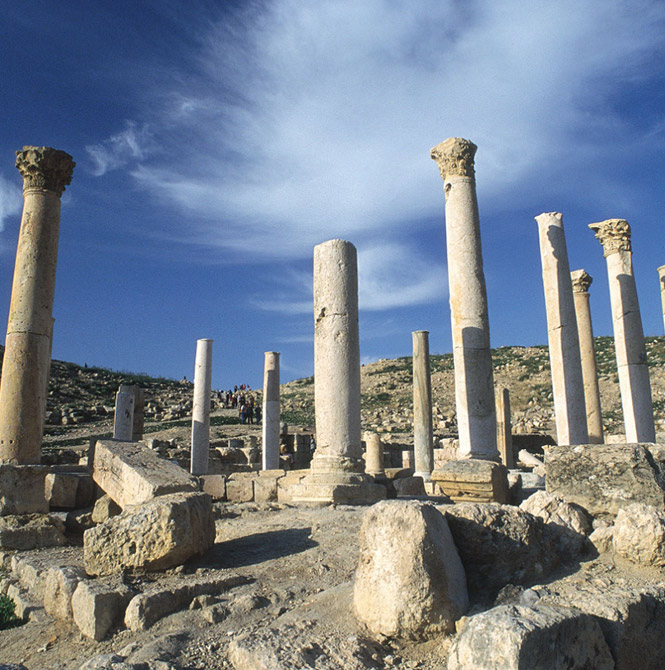
The city of Pella (Ṭabaqat Faḥl) has always been under occupation since the Stone Age. It was first mentioned in the nineteenth century BC in Egyptian writings, and later took a Greek name, perhaps to commemorate the birthplace of Alexander the Great. During this period, Pella was one of the Ten Cities (the Decapolis). Christianity spread in Pella, and it was in the city one of the oldest churches, according to the historian Eusebius of Caesarea. It was a haven for Jerusalem Christians who fled from the Jews and Romans in the first century AD. The city was destroyed by an earthquake in 746, and the remains of a small village remain.

The history of the city of Pella (Ṭabaqat Faḥl) dates back to thousands of years before Christ. During the golden era of the Pharaohs, it was called "Behelium", and it had commercial relations with the pharaohs before they invaded and seized it, as evidenced by some of the writings found by archaeologists in Egypt and dating back to Pharaoh Sesostris III in the year 1840 BC.
With the conquests of Alexander, the Great (356-323 BC), Pehelium was subjected to Greek rule and civilization. Pella did not take its current name until 310 BC when a large number of Macedonians in northern Greece fled to it, and changed its name from Pehelium to Pella in memory of Pella, the capital of Macedonia, the birthplace of Alexander the Great. It is worth noting that Ptolemy II Philadelphus (285–186 BC), who propagated the Greek civilization, changed the names of some cities with Greek names such as the goddess of Ammon (Amman), which took the name Philadelphia, and Pella bore the name Arsinoe, but soon the name Pella prevailed over it.
The Roman commander Pompeius ended the Greek hegemony in Syria, Palestine and Jordan in 64 BC and organized the country's administration. He established the Decapolis Alliance, and Pella was one of those ten cities. This alliance remained in place until it was re-divided in the fourth century AD until the era of the Arab conquests. Bella surrendered to Abu Ubaidah in 635 AD.
Christianity spread in Pella (Ṭabaqat Faḥl) from its inception. The ecclesiastical historian Eusebius of Caesarea (264-340 AD) stated that Vesepianus entrusted his son Titus with the order of war against the Jews in the year 68 AD. And then the Christians realized that the time of the destruction of Jerusalem, which Jesus had predicted, was approaching. They left the city, with their bishop Simon at their head, and landed in the city of Pella and its suburbs.
In the second century AD, the famous writer Ariston was born in Pella, who wrote in defense of Christianity his book: “The Dialogue between Jason and Babskos about Jesus.” The book came in the form of a dialogue between a Christian and a Jew about Jesus and the fulfillment of the prophecies of the Old Testament. This book is missing, but the scholar and philosopher Origen (185-253 AD) in his huge work "Against Celsus" mentions this controversy in his book.
The bishops of Pella participated in many ecclesiastical councils, including the Second Council of Ephesus in 449 AD, which was later called the Council of Thieves, and the Council of Chalcedon in 451 AD, which was held after the previous council to nullify its work and prove the sanctity of Eutyches, who deviated from the church’s teachings regarding the doctrine of the mystery of the Incarnation. The bishops of Pella also participated in other regional councils in Jerusalem in 518 AD and another in 536 AD.
As for the most important Christian monuments of Pella, it is the Western Church with its three naves and the front courtyard. It was built in the fifth century and was decorated with white marble and mosaics. The Persians destroyed this church in 614 AD, but the people of the city restored it. There are also two churches, one in the east of the city and the other behind the stadium. As for the Diocese of Bella, it was bordered to the west by the Jordan River, to the north by Wadi Taybeh and Wadi Arab, to the south by Wadi Kafrnaja, and to the east by the alignment of Ajloun and the borders of the Diocese of Irbid and Al-Hosn. An earthquake in 746-747 AD destroyed the city and its churches, and its people fled from it, leaving them in ruins.